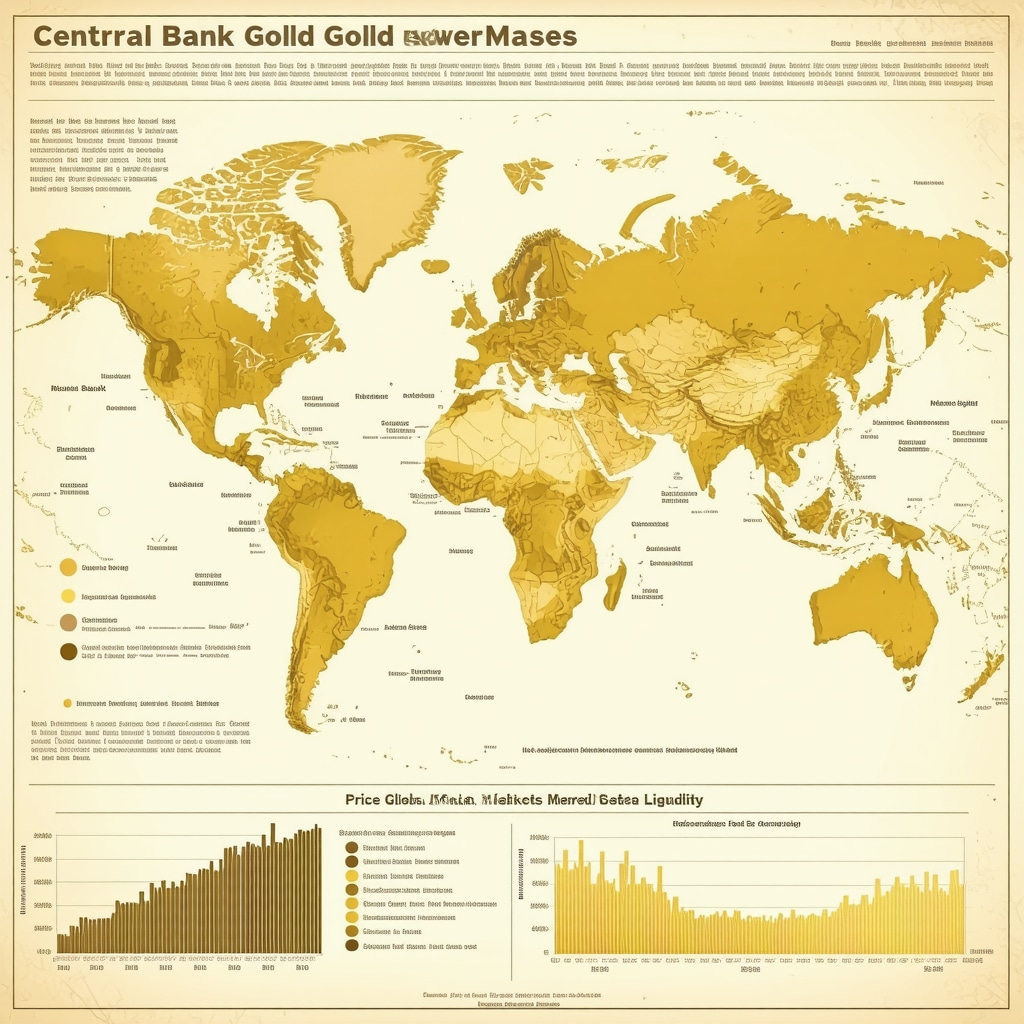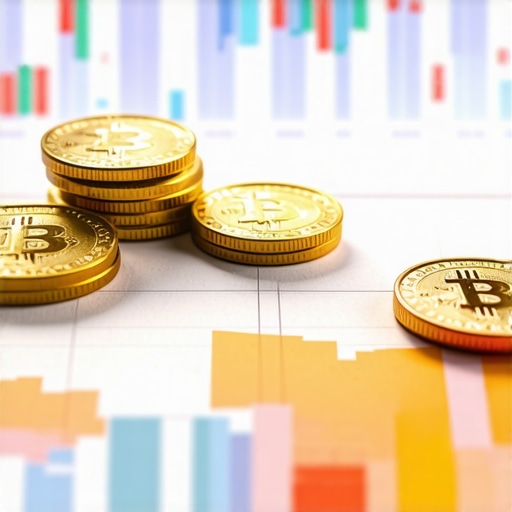When Central Banks Go on a Gold Buying Spree: What’s the Market Buzz?
Imagine a quiet room where the world’s financial giants gather, not to discuss crypto whims or stock market antics, but to quietly stockpile one of humanity’s oldest treasures: gold. Central banks have been stealthily ramping up their gold purchases as we edge into 2025 — and trust me, this isn’t just a shiny fad. It’s a seismic shift with ripples that investors, analysts, and even casual market watchers can’t afford to ignore.
Gold’s New Role on the Global Stage: More Than Just a Pretty Metal
Gold has always been the go-to hedge against uncertainty, but central banks increasing their bullion reserves signals a deeper, strategic recalibration. This trend reflects a growing skepticism about fiat currencies and a desire to diversify reserves amidst geopolitical tensions and inflation anxieties. As currencies wobble and the specter of economic turbulence looms, gold’s allure intensifies. The impact on price volatility is palpable, with markets reacting swiftly to these institutional moves.
Are Central Banks Changing the Rules of the Gold Game?
Here’s a question worth chewing over: With central banks snapping up gold, are they reshaping the fundamental dynamics of the gold market itself? It’s not just about buying metal; it’s about signaling confidence, influencing prices, and perhaps even nudging private investors to rethink their portfolios. The strategic accumulation can tighten supply, drive prices up, and inject a new layer of complexity into trading strategies. For savvy investors, understanding these shifts is crucial — more so than ever before.
Why You Should Care: The Ripple Effects on Your Investments
Central bank gold purchases don’t happen in a vacuum. They affect everything from the price forecasts to the volatility that traders dread and crave in equal measure. If you’re considering diversifying your assets, the analysis of how these purchases drive prices up offers invaluable insights. Plus, with inflation fears still stubbornly present, gold remains a beacon of stability.
For those curious about leveraging gold to shield against market storms, exploring how to use gold as a hedge against market uncertainty is a smart next step.
What the Experts Say: Trust but Verify
Industry authorities like the World Gold Council consistently highlight how central bank buying patterns influence global demand and pricing. According to a recent World Gold Council report, these purchases can have outsized effects on market liquidity and investor sentiment, often pre-empting broader economic shifts. Understanding this interplay elevates your investment game from guesswork to informed strategy.
Ready to Dive Deeper? Share Your Thoughts!
Gold’s story in 2025 is still being written, with central banks playing a starring role. Are you adjusting your portfolio to this golden trend, or watching from the sidelines? Let’s spark a conversation — your insights and questions could illuminate the market for many. Drop a comment below or explore more on how central bank gold purchases affect market dynamics.
Central Banks and Gold Reserves: A Strategic Chess Game Beyond the Surface
When central banks increase their gold reserves, it’s not just a transactional move; it’s a strategic maneuver with far-reaching implications. These institutions, acting as custodians of national financial stability, often anticipate economic tremors ahead of public perception. By bolstering gold holdings, they create a buffer against currency devaluation, geopolitical risks, and inflationary pressures. This strategic accumulation can alter market liquidity, tighten supply chains, and set off ripple effects felt across global markets.
Investors must appreciate that central banks operate on a different timeline and with distinct objectives than private market players. Their purchases signify a long-term commitment to gold as a cornerstone of reserve portfolios, which in turn recalibrates expectations for price stability and growth.
How Do Central Bank Gold Purchases Interact with Market Volatility in 2025?
The relationship between central bank gold buying and market volatility is nuanced. On one hand, large-scale purchases can reduce available gold in the open market, constricting supply and potentially causing price spikes. On the other hand, the signal of confidence these buys send can stabilize investor sentiment, reducing panic-driven sell-offs in turbulent times.
This dual effect challenges traders and portfolio managers to refine their strategies, balancing between capitalizing on price movements and safeguarding against abrupt shifts. For those interested in mastering these dynamics, exploring best gold trading techniques offers practical guidance tailored for the evolving market environment.
Is the Central Bank Gold Buying Trend a Harbinger of a New Monetary Paradigm?
The critical question for economists and investors alike is whether the renewed fervor for gold signals a fundamental shift away from fiat currency reliance. As central banks diversify reserves, could this be the prelude to a redefined monetary system where gold regains prominence as a global standard? While it’s premature to claim a full-scale return to gold-backed currencies, the pattern undeniably hints at a cautious recalibration of trust in traditional monetary frameworks.
In-depth analysis from the International Monetary Fund underscores how such moves could influence global liquidity and exchange rate mechanisms, suggesting that gold’s role may evolve beyond a mere safe haven to a strategic asset underpinning global finance (IMF Working Paper, 2023).
Implications for Investors: Navigating the Gold Market’s New Landscape
For investors, understanding the motivations and consequences of central bank gold buying is paramount. It shapes how one approaches diversification, risk management, and portfolio resilience. Physical gold, ETFs, and mining stocks each respond differently to central bank activities. Engaging with resources like top gold ETFs and mutual funds can help investors build balanced exposure aligned with this shifting landscape.
Moreover, staying informed about the latest market analysis and price forecasts enables more agile decision-making. For example, reviewing gold price forecasts for 2025 helps anticipate potential market movements influenced by central bank behaviors.
Join the Conversation: How Are You Adjusting to Central Banks’ Gold Buying Surge?
As central banks redefine their gold strategies, your insights and experiences become invaluable to the community. Are you shifting your portfolio to harness these trends, or adopting a wait-and-see approach? Engage with fellow investors by sharing your thoughts in the comments below. For a deeper dive into market impacts and smart investment tactics, explore our detailed analysis on how central bank gold purchases affect market dynamics.
Unveiling the Complex Strategies Behind Central Banks’ Gold Accumulation in 2025
While the headline numbers on central bank gold purchases might seem straightforward, the underlying strategies are anything but. These institutions are not merely stockpiling gold; they are engaging in a multifaceted maneuver that intertwines geopolitical risk management, monetary policy signaling, and portfolio diversification on a scale that dwarfs private investors.
Central banks often time their acquisitions tactically, responding to macroeconomic indicators and global events that forecast currency pressure or financial instability. For instance, during periods of rising inflation expectations or escalating geopolitical tensions, gold becomes a preferred asset to fortify reserves. This intentional timing can amplify price impacts, as market participants anticipate and react to these institutional moves.
How Do Central Bank Gold Purchases Influence Liquidity and Price Discovery in Global Markets?
This question probes a sophisticated market dynamic. Central bank buying reduces physical gold availability, constricting supply and potentially heightening price volatility. Yet, paradoxically, their purchases can also stabilize markets by signaling confidence in gold’s value as a reserve asset. The interplay affects liquidity in futures markets and the behavior of speculative traders, often leading to complex feedback loops.
According to the World Gold Council’s latest research, central bank activity influences not only spot prices but also derivatives markets, shaping how price discovery unfolds. This dual effect requires investors to carefully analyze volume trends, open interest, and geopolitical narratives to gauge potential price trajectories.
Integrating Gold into Portfolio Risk Management: Advanced Approaches for 2025
Incorporating gold into a diversified portfolio is more nuanced than simply allocating a fixed percentage to bullion or ETFs. Investors must consider correlations, liquidity profiles, and the evolving impact of central bank behaviors. Dynamic allocation strategies that adjust exposure based on macroeconomic signals and central bank buying patterns can optimize risk-adjusted returns.
Moreover, mining equities and gold-related derivatives offer alternative avenues to leverage central bank trends. These instruments often respond more sensitively to price fluctuations and central bank announcements, providing tactical opportunities for sophisticated traders.
What Are the Long-Term Implications of Central Banks’ Gold Buying on Global Monetary Stability?
The sustained increase in gold reserves by central banks may be indicative of a gradual redefinition of monetary trust paradigms. As fiat currencies face mounting challenges, gold’s role could transition from a passive hedge to an active monetary anchor, influencing currency valuations and international liquidity frameworks.
Notably, a 2023 IMF working paper explores scenarios where gold underpins new reserve architectures, potentially reducing reliance on dominant fiat currencies and reshaping exchange rate dynamics. This evolving landscape demands that investors and policymakers alike deepen their understanding of gold’s strategic functions.
Advanced Tools and Resources to Track Central Bank Gold Movements
Given the opacity often surrounding central bank gold transactions, leveraging cutting-edge analytics and data platforms is essential. Services providing real-time aggregate data, shipment tracking, and geopolitical risk assessments empower investors to anticipate market shifts more accurately.
For example, platforms integrating satellite imagery of gold vault activity or blockchain-tracked bullion certificates are emerging as innovative tools for transparency. Keeping abreast of these technologies enhances the ability to react swiftly to central bank signals.
Engage with the Experts: Elevate Your Gold Investment Strategy
Central bank gold purchases are reshaping the investment landscape in complex ways. Are you equipped to decode these shifts and adapt your strategies accordingly? Join our expert forum to discuss nuanced tactics, share insights, and access exclusive analyses tailored for advanced investors. Dive deeper into how central bank gold purchases affect market dynamics and transform your approach today.
Unpacking the Subtle Art of Central Bank Gold Accumulation Strategies
Central banks’ gold purchase patterns in 2025 reflect a complex choreography balancing risk mitigation, geopolitical signaling, and monetary policy adaptation. These sovereign entities don’t merely accumulate gold as a static asset; they orchestrate acquisitions timed to forecast economic shifts and fortify national financial resilience. This strategic layering impacts global gold availability and indirectly shapes investor behavior.
How Do Central Bank Gold Purchases Affect Market Liquidity and Price Discovery Mechanisms?
Delving into the intricate interplay between central bank gold buying and market dynamics reveals a paradox: while large-scale reserves accumulation tightens physical supply—potentially triggering price surges—it simultaneously acts as a stabilizing signal endorsing gold’s intrinsic value. This duality influences liquidity across spot and futures markets, complicating price discovery processes.
According to the World Gold Council’s 2024 analysis, central bank interventions shift speculative flows and recalibrate market expectations, often preceding broader economic recalibrations. For traders and portfolio managers, deciphering these signals is critical to navigating volatility and optimizing entry points.
Leveraging Advanced Gold Investment Vehicles: Tailoring Portfolios Amid Central Bank Trends
As central banks pivot towards gold, investors are urged to diversify beyond physical bullion, embracing instruments like gold ETFs, mutual funds, and mining equities. Each vehicle responds uniquely to central bank buying patterns, offering differentiated exposure and liquidity profiles.
Exploring top gold ETFs and mutual funds enables investors to build resilient portfolios attuned to the evolving gold landscape. For those seeking tactical approaches, mining stocks present high-reward opportunities but demand acute risk assessment aligned with central bank signals.
What Emerging Technologies Are Enhancing Transparency in Tracking Central Bank Gold Movements?
In an era where opacity often shrouds central bank transactions, innovative tools leveraging satellite surveillance, blockchain authentication, and AI-driven analytics are revolutionizing market transparency. These technologies enable real-time monitoring of gold shipments, vault activities, and geopolitical risk factors influencing central bank decisions.
Harnessing such advanced resources empowers investors to anticipate market shifts with greater precision, transforming reactive strategies into proactive positioning. This technological frontier is reshaping how stakeholders interpret central bank gold purchasing data and its market implications.
Join the Dialogue: How Are You Integrating Central Bank Gold Trends Into Your Investment Strategy?
With central banks increasingly shaping gold’s market trajectory, your perspectives are invaluable. Are you recalibrating your portfolio to align with these institutional moves, or taking a cautious stance amid uncertainty? Share your insights and questions below to enrich our collective understanding. For a comprehensive exploration of central bank influences on gold markets, delve into our full analysis at how central bank gold purchases affect market dynamics.

Expert Insights & Advanced Considerations
Central Banks Signal a Paradigm Shift in Reserve Management
The aggressive increase in gold acquisitions by central banks throughout 2025 reflects a strategic departure from traditional fiat currency reliance. This trend underscores a recalibration towards tangible assets as a bulwark against inflationary pressures and geopolitical uncertainty, signaling potential shifts in global monetary frameworks.
Supply Constraints Amplify Price Discovery Complexity
Central bank gold purchases reduce available physical supply, tightening market liquidity and complicating price discovery mechanisms. This dual effect can cause short-term volatility spikes while simultaneously providing a foundational confidence signal that tempers speculative extremes, demanding sophisticated analysis from market participants.
Dynamic Portfolio Allocation Becomes Imperative
Investors must increasingly embrace dynamic allocation strategies that respond to central bank buying patterns and macroeconomic indicators. Incorporating a diversified mix of physical gold, ETFs, and mining equities—each with distinct risk and liquidity profiles—enables a more resilient stance against market fluctuations and inflation risks.
Emerging Technologies Enhance Transparency and Strategic Timing
Innovations such as satellite monitoring, blockchain certification, and AI-driven analytics are revolutionizing transparency around central bank gold movements. These tools empower investors to anticipate institutional buying signals more accurately, transforming reactive approaches into proactive strategy execution.
Gold’s Evolving Role as a Strategic Monetary Asset
Beyond its traditional safe-haven status, gold is increasingly regarded as an active monetary anchor influencing currency valuations and global liquidity configurations. This evolution necessitates that investors and policymakers deepen their understanding of gold’s multifaceted roles in a complex, shifting economic landscape.
Curated Expert Resources
- World Gold Council Central Bank Research: Offers authoritative, up-to-date analysis on central bank gold purchases and their macroeconomic impact, essential for grasping market dynamics (https://www.gold.org/goldhub/research/central-bank-purchases).
- IMF Working Paper on Gold’s Role in Central Banks (2023): Provides in-depth exploration of gold’s potential to redefine reserve architectures and influence exchange rates (https://www.imf.org/en/Publications/WP/Issues/2023/07/01/The-Role-of-Gold-in-Central-Banks-523765).
- Gold ETFs and Mutual Funds: Top Picks for Diversification: A comprehensive guide to selecting instruments that align with evolving central bank trends (https://buyingoldnow.com/gold-etfs-and-mutual-funds-top-picks-for-diversification).
- Advanced Gold Trading Techniques to Boost 2025 Market Profits: Tactical insights for leveraging market volatility created by institutional movements (https://buyingoldnow.com/best-gold-trading-techniques-to-boost-2025-market-profits).
- How Central Bank Gold Purchases Affect Market Dynamics: Detailed analysis on the interplay between sovereign buying and global gold price behavior (https://buyingoldnow.com/how-central-bank-gold-purchases-affect-market-dynamics).
Final Expert Perspective
The surge in central bank gold buying throughout 2025 is more than a mere accumulation of metal—it represents a profound strategic recalibration within the global financial ecosystem. This movement tightens supply, influences price volatility, and recasts gold’s role from a passive hedge to a pivotal monetary asset. Investors navigating this landscape must adopt nuanced strategies that integrate dynamic portfolio allocation, leverage emerging transparency technologies, and maintain acute awareness of geopolitical currents.
For those seeking to deepen their expertise and adapt effectively, engaging with resources like top gold ETFs and mutual funds and mastering how to use gold as a hedge against market uncertainty can be transformative steps.
What’s your take on this unfolding gold narrative? Dive into the conversation, share your professional insights, and explore deeper analyses at how central bank gold purchases affect market dynamics. The future of gold is being shaped today—are you ready to lead the charge?











This article offers a comprehensive overview of the growing influence central bank gold purchases have on global markets. I have noticed that many investors overlook how these institutional moves affect liquidity and price discovery, often focusing solely on retail activity. In my experience, understanding the timing and scale of these purchases can provide significant strategic advantages, especially when combined with emerging technologies like blockchain tracking and satellite monitoring. I wonder, though, how much shorter the lead time becomes for traders to react effectively to these signals as technology advances. Has anyone experimented with integrating real-time central bank activity data into their trading algorithms? It seems like staying ahead of the curve in this space requires both sophisticated analysis and rapid execution. What approaches or tools have others found effective for managing the increased volatility and liquidity constraints driven by these institutional moves? It’s an exciting yet challenging landscape for both seasoned and new investors alike.